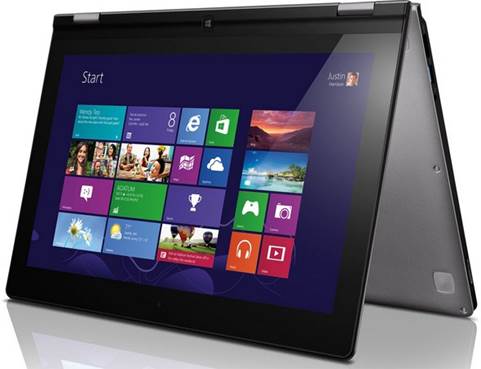Keyboard and trackboard
Like any other loyal customer, Lenovo will
remind you that the keyboard of the IdeaPad laptop series of the company is so
different from any keyboard that you have seen in the ThinkPad series, but
generally, they have some similarities: the same U-shaped “Smile” key, with the
blank response and surprising amount of travel (see the ThinkPad X1 Carbon and
IdeaPad U310 as an example). That means it does not seem to be the best
performance of Lenovo. Even after one week of using, we still keep the thought
that the keyboard did not completely recognize every presses of us – regularly,
we have to press the Backspace and re-type many letters that you meant to type.

IdeaPad
Yoga 13’s Keyboard
About the Backspace button, it is super
small, and so hard to find with the finger if you do not looking at the
keyboard when typing. Other important keys are also shrunken, such as Enter,
Caps Lock and Tab. There is no doubt that it is such an effective layout, and
it is still better than what you can find on other Ultrabooks. It is not freely
setting like some other keyboards of Lenovo. In case you are wondering, the
keyboard does not have the backlit, just like the last year U300s. That seems
to be strange for such an expensive laptop, but it really does not diminish the
usability of the machine. We pay more attention to the key travel and the
button size.
Yoga 13 owns a large glass trackpad which
supports any of the Windows 8 gesture that you make on the touchscreen – for
example swiping from the right to open Charms bar,.. Mainly, it works great,
although we struggled a little bit when talking about swiping from the
trackpad’s top to display menu settings and open tabs on IE 10. Moreover,
classic multi-touch gestures like pinch-to-zoom and two-finger scrolling
perform smoothly. However, we still faced some problems with one-finger
navigation: usually, the cursor will stops in a moment on the screen before we come
to whatever we want to click. On the good side, the built-in button on the
trackpad is easy to press, and makes no audible sound.
Display and sound

The
view from the off-angle
The good thing of having many Windows 8
evaluating unit around is easy to compare every competitive touch screen side
by side. Even when standing between so many competitors, Yoga 13 still looks
pretty good. The 1,600x900, 300-nit IPS panels look considerably livelier
beside other more moderate 1,366x768 displays, although it is not as impressive
as the 1080p displays which operate on the XPS 12 and Acer Aspire S7. Both of
these machines have very high starting price, so does anybody feel surprised
because they have the good displays?
Besides the pixel density (we thought 1,600x900
is good enough for many people), the view angle is as wide as what you expect
on the IPS display: you will not have to encounter any problems when working
with the machine in your lap or share the screen with other friends when
watching Netflix. We also think that the touchscreen very quickly responsive –
it usually quickly recognize many of our presses and swipes.
As how we usually mention the Ultraportable
laptop, the sound quality is rather low, but that distortion really seems more
subtle here. Obviously, heavy-bass music types will not be heard as what the
singers expected, but at least, it is so interesting to hear, which we cannot
say about every thin and light laptop that comes to our working desks.
Performance and battery life
Lenovo
IdeaPad Yoga
·
Core i5-3317U 1.7 GHz, Intel HD 4000
·
PCMark7: 4,422
·
3DMark06: 4,415
·
3DMark11: E917/P572
·
ATTO (the highest disk speeds): 178 MB/s
(reads); 263 MB/s (writes)
Toshiba Satellite U925t
·
Core i5-3317U 1.7GHz, Intel HD 4000
·
PCMark7: 4,381
·
3DMark06: 4,210
·
3DMark11: E989/P563
·
ATTO: 521MB/s (reads); 265MB/s (writes)
Dell XPS 12
·
Core i5-3317U 1.7GHz, Intel HD 4000
·
PCMark7: 4,673
·
3DMark06: 4,520
·
3DMark11: N/A
·
ATTO: 516MB/s (reads); 263MB/s (writes)
Acer Asphire S7
·
Core i7-3517U 2.4GHz, Intel HD 4000
·
PCMark7: 5,011
·
3DMark06: 4,918
·
3DMark11: E1035/P620/X208
·
ATTO: 934MB/s (reads); 686MB/s (writes)

Yoga
13’s performance
At least, when talking about battery, we
have had the bad luck with convertible Windows 8 machines. Dell XPS 12 lasted 5
hours and 30 minutes in the standard test, whereas it is 20 minutes earlier for
the Satellite U925t to use up its power. Acer Aspire S7 (which is not a
convertible but a touchscreen laptop) offers bad battery life – it just lasted
4 hours and 18 minutes in the same test. Yoga 13 was on the same field: it
lasted 5 hours and 32 minutes replaying the video, with Wi-Fi on and the
constant brightness of 50%.
As you can see, it is better than any
Windows 8 machine that we have mentioned, but this does not really tell much –
when non-touch Ultrabooks can last 6 or even 7 hours for a charging period.
Yoga 13’s battery life is not really bad, in its segments where it belongs to,
but we are hoping that the next generation of these devices will provide better
battery.